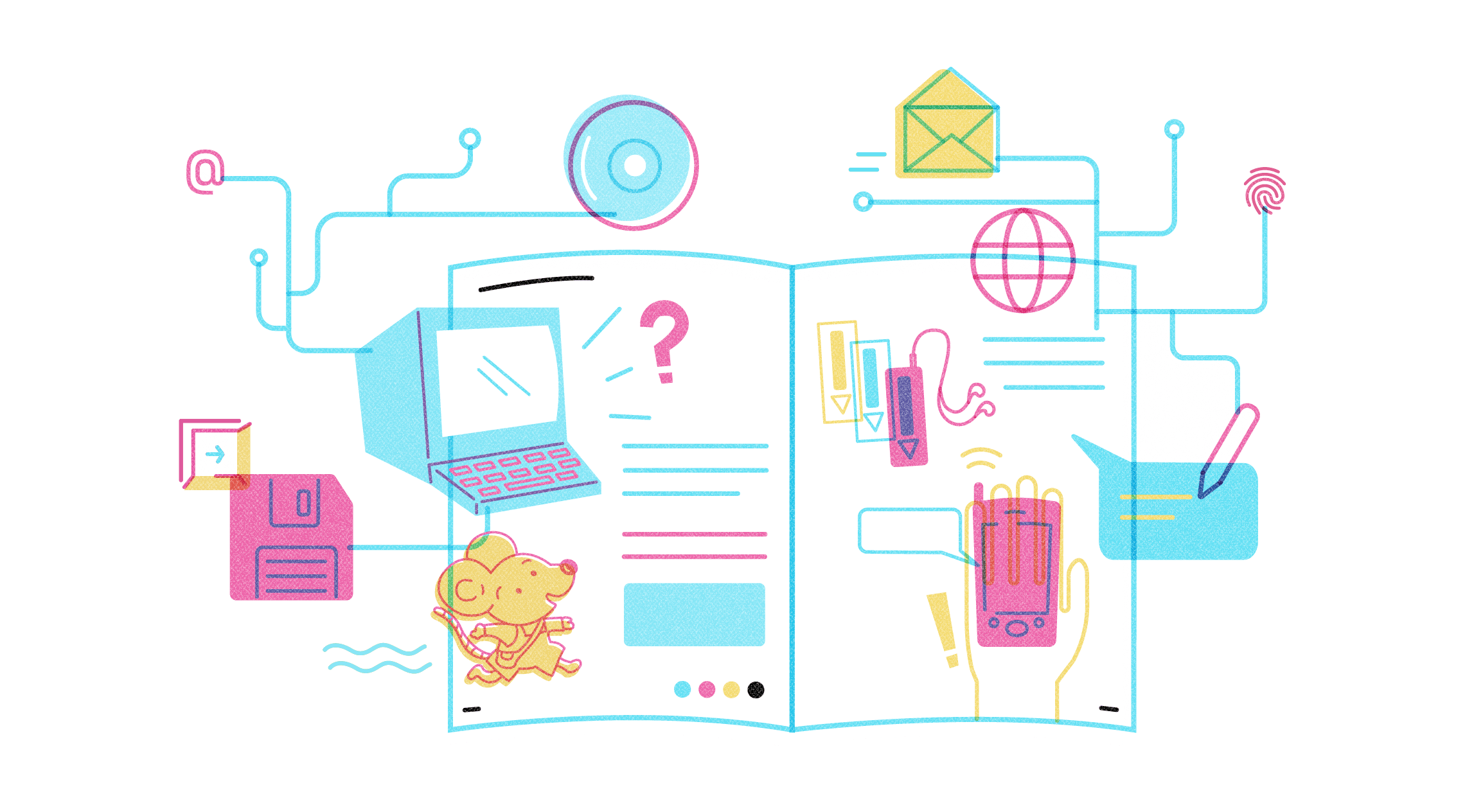I stared blankly at a blinking C on the screen in front of me. “Well, do something,” my brother Kishore said. But I had no idea what to do with the contraption that had just replaced my beloved jade-green Hermes typewriter. My family had decided it was time for me to move on from the typewriter age and had planted a ‘PC XT’ on my study table. I wouldn’t have been able to guess how that hulk of a computer would soon change my life.
Kishore Bhargava, my brother and an IT consultant, had been using a PC since 1985 and was one of a small community of ‘techies’ who spoke in tongues only insiders understood. Before 1995, if you asked anyone whether they used a PC, they would be horrified. “No, no, I really am very bad at maths,” some would say. Computers belonged in labs and offices.
But everything was about to change. In pre-internet India, a bunch of tech enthusiasts set up Bulletin Board Systems or BBSes, which brought in an early form of “messenger” and discussion groups. “We had only a few of these BBSes in India, so they were really busy,” says Kishore, who was a ‘Sys-Op’ or system operator of his own BBS. “People would dial in and talk about anything at all, such as where in Nehru Place to buy computer parts or where to eat. We even had a special discussion group for women.”
The world of the bulletin boards was so mysterious that Star TV got wind of it and came to my house with a camera crew, hell-bent on shooting me posting messages. They added blue lighting to add to the atmosphere of mystery. The crew was fascinated when I explained what the BBSes were about. But they thought something was missing: why was there no dating? So they splashed their own text on my computer screen: I think you’re groovy and I have the weekend.
It took me many years to live this down because Star TV used that snippet as a filler between programmes. Thanks to that, a lot of people looked at me strangely for a long time.
Luckily, Star TV dropped that filler when the internet became available in India. I didn’t know then that I would become so involved in the story of how technology became a part of everyday life in India. For me, it all happened through the making of a warm, fuzzy magazine.
The internet was all text and gibberish UNIX commands. You couldn’t do much with it.
‘India Internet’
wenty five years ago, on 15th August, Videsh Sanchar Nigam Limited (VSNL) began offering internet services in India. No one would connect the way the internet looked then with the way it does now. I was baffled by my first look. It was all text and gibberish UNIX commands. You couldn’t do much with it. But the World Wide Web was just around the corner.
Haunting the BBSes and owning a computer had made me tech-savvy. I began to write for PCQuest, the very first computer magazine in the country, started way ahead of its time in 1982. I wrote on software and products like printers, but what was most popular was my column called ‘India Internet.’
Early adopters had just begun using the internet, though accounts were very expensive and only the top companies could afford connections. There were cheaper student accounts for the princely sum of ₹500, but you could only use them until your minuscule allowance of data ran out.
So the mischievous tech community figured out how to write a script to be able to use the full access accounts of companies. The passwords were easy to guess—inevitably the name of the company itself. We practically lived in their internet accounts. One of us even got into the email account of the VSNL chief and naughtily sent out a message to his entire contact list: “Nobody loves me! Boo hoo. I’m going to cry.”
Using the internet was anything but simple for ‘newbies,’ as techies called them. There was no Google and no one knew what to make of “http.” Those days, the average user had to know the address of a website to get to it, so I wrote about things like where to find interesting medical information.
Readers were fascinated. So was Cosmopolitan magazine, which came and interviewed me to figure out if there was something worthwhile on women’s sexuality on the internet. They later wrote that I rubbed my hands in glee and said there could be.
I had graduated to a 386 assembled computer with 2MB of RAM, a 20MB hard disk and three-and-a-half inch floppy drive. I can’t help comparing that to the phone I now slip into my handbag: Samsung’s ZFold 2 has 12GB of RAM and 256GB of storage.
Something more powerful was to come along in the late 1990s—the multimedia computer. It meant that CDs and CD drives had arrived. Today’s young people wouldn’t look twice at a CD, if one can be found, but back then, it was a revolution and an audio-visual feast. I had a fantastic time writing about the CDs that filtered in for review. I especially remember Microsoft Oceans—that one was as good as a Discovery show.
PC Quest’s writing on the internet and multimedia attracted a fair amount of reader response. Editor Prasanto K Roy found that two items got particularly high traction. “Mala’s writing and Atul Chitnis’ COMversations were almost chatty pieces that talked to the reader, even tech newbies,” he says. “This gave us a good idea that there was an untapped audience for whom we decided to launch a separate magazine.”
So barely a year after the internet and multimedia PCs made their appearance, I joined CyberMedia, which brought out PCQuest, full time to put together this new publication. I didn’t know a thing about the world of publishing.
More than that, I had no inclination to join any organisation as I have extremely poor eyesight which isn’t correctable. I worried that I would be a liability. I promised to “help from home” by writing for the new magazine. Instead of trying to get the job, I tried hard to un-get it by explaining my problem.
My diffidence came from a defining life experience. For years, I had wanted to be a clinical psychologist. I had studied psychology as well as worked at AIIMS for some seven years. Despite acing the entrance exam thrice, NIMHANS, the only institution that offered a degree in Clinical Psychology at the time, wouldn’t have me. “We think you need to further your qualifications, but go do it elsewhere. You will be a liability to our profession.” Shell-shocked, I gave up on psychology.
Today, I’d like very much to go back to NIMHANS and effusively thank those gentlemen for barring me from a profession with so little heart. At CyberMedia, the publisher Pradeep Gupta paid no heed to my protests and told me to turn up the following Monday—and that was that.
Conceptualising the new magazine was probably the best time of my life. A group of us would sit around in shorts in Pradeep Gupta’s home, brainstorming and planning. We came up with the name Computers@Home and thought the @ very cool, though many people pronounced it ‘at the rate of’ for years after.
“Go champion the cause of home computing in India,” Pradeep Gupta said to me. I breathed and lived that mission completely until I left the organisation nine years later. In 1996, I was so fired up that I actually pre-designed the magazine on PageMaker 5 at home, printed it on A4 Bond paper and brought it to work one day. It ended up being the blueprint for the briefing to the design agency. From then on, working on Computers@Home was the only thing I wanted to do. One night, I was still in office at 11pm when the managing editor Shyam Malhotra told me to get a life and go home. I cried from sheer indignation.
The age of persuasion
nanda Swaroop used to head operations at Media Workshop, the agency that designed Computers@Home. “We were really excited when we were given this totally different brief of designing a publication that was really personal and friendly, with a look and feel that spoke of warmth and drew in the reader as being one of us,” she says.
“This was entirely different from Dataquest, the IT industry magazine (also a CyberMedia title) which was business-like. For Computers@Home, we needed different imagery and elements. So we used rounded corners, lots of colour, and even slightly off-white matte finish paper.”
Media Workshop even designed a mascot, a little she-mouse we named Megabyte. She would perch over a headline or sit by a gadget. For many years, we also used Sesame Street muppets to make it look like they were interacting with the devices and commenting on them. It was all part of making the magazine non-threatening for someone who was wary of trying out a computer.
When we launched the magazine in October 1996, it was with the enthusiastic support of the tech industry. We began with a ‘sampler’ issue and a special scheme. “We kicked off with a three-month free subscription offer for which we teamed up with Diners Club and Citibank. We also ran ads in the main newspapers,” says Vishaal Bhatnagar, Computers@Home’s first product manager.
The response took us by surprise. “The horrified postmen brought in coupons for that free subscription by the sackful. We had nowhere to store them,” says Vishaal. It was exhilarating to learn that the audience was even larger than imagined, but we worried about honouring our free subscription promise. Eventually, we had to stagger the fulfilment.
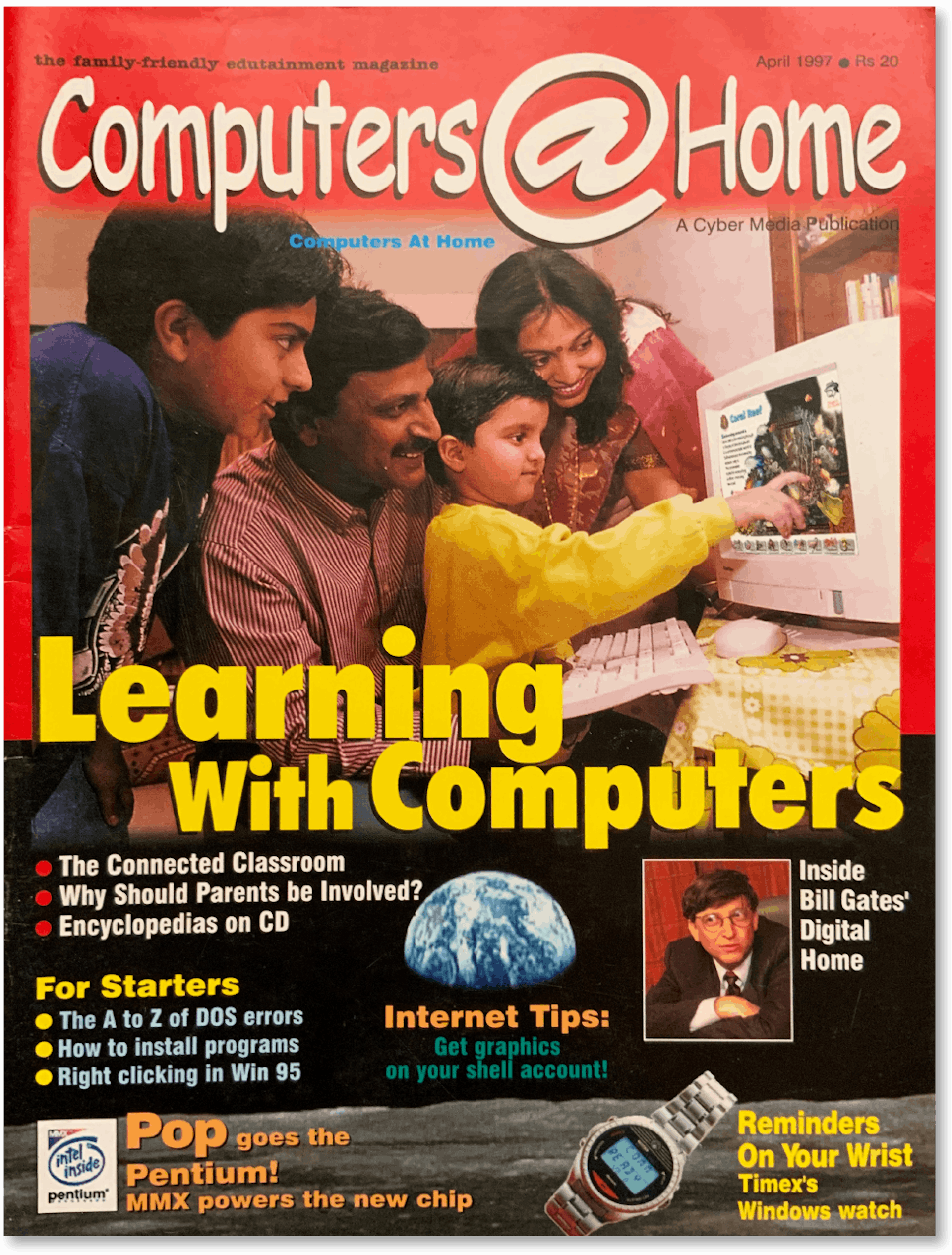
By the second issue of Computers@Home, the magazine turned out so wonderfully that Pradeep Gupta called me on the internal line and said: “Mala, if there’s ever a magazine I dreamt of, this is it.” I think I cried.
Computers@Home had a tiny room for an office where our little team of three sat in a dank corner, not caring too much about the septic tank above us. Every now and then, it would overflow, forcing us to get out. We’d impatiently wait for someone to come fix it quickly so we could get back to work. In nine years, this magazine was never late.
At the PCQuest “labs,” the team tested printers, UPSes and cameras. Once, 40 modems were tested in a one-of-its-kind shootout. We were so steeped in our work that I barely noticed the world outside. I remember once during a meeting sending my driver off to Pizza Hut with a written order for our pizzas. He returned very frazzled, 45 minutes later, and said that Pizza Hut didn’t have what we wanted. In annoyance, I snatched the piece of paper with our orders from him. “Two 56k modems,” is what it said. We had no lunch.
I held my breath for questions. I got one. “What will happen to the child’s handwriting?”
Debjani Ghosh, now president of the influential IT industry body NASSCOM, had just joined Intel at the time. “We knew that there was huge potential, but we also knew we would have to drive market creation,” she remembers. “At the time, the PC ads were all about configurations. That’s all they would sell on. This meant nothing to a parent sitting at home. So we launched Project Vidya and kicked off a full-fledged campaign: print advertisements, ‘PC melas,’ tie-ups with schools and science museums.”
But one community that was the most difficult to persuade was that of school teachers. I once went and gave a lively presentation to 200 of them to showcase how one computer and the internet could bring life to teaching. At the end, I held my breath for questions. I got one. “What will happen to the child’s handwriting?”
Intel also found that it wasn’t good enough to just set up computer stations in schools for everyone to try out. The students loved it and the teachers hated it. So they began a pan-India train-the-trainer programme that gradually brought teachers up to speed.
At CyberMedia, Pradeep Gupta took the initiative to persuade IT companies to give jobs to people with disabilities. I was the star campaigner—my visual disability didn’t seem to get in the way of my work in any insurmountable way. In 2000, I delivered an impassioned presentation to two groups of IT CEOs. Chief ministers Sheila Dikshit and SM Krishna attended in Delhi and Bengaluru respectively. I asked whether they would really hire someone who came in on a wheelchair and had trouble being understood. Then, I flipped the slide to a picture of Stephen Hawking. If that didn’t do it, nothing would.
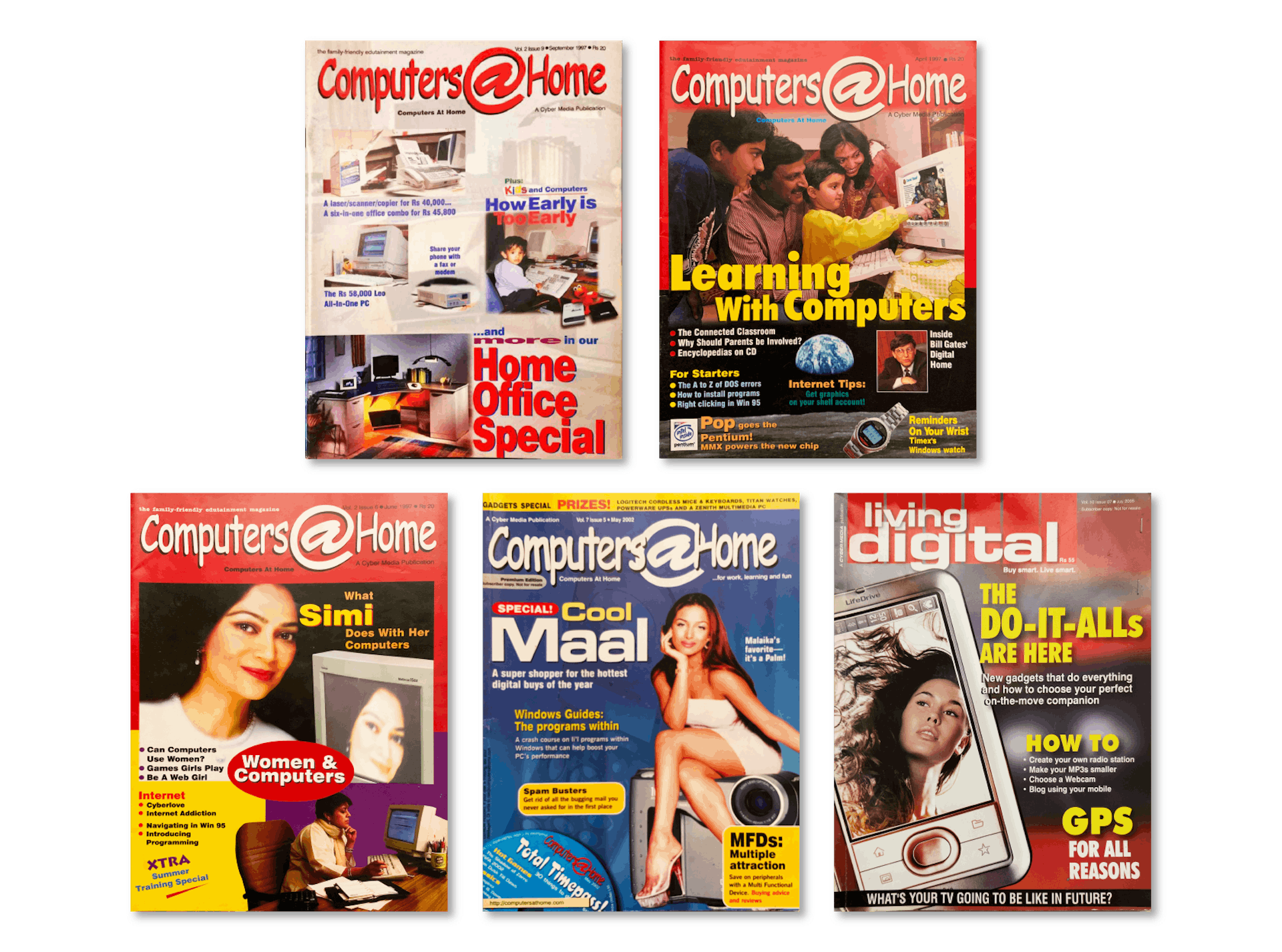
Photo Credit: CyberMedia India
Fan mail
eaders responded warmly to the unusual design. The bond they formed with us was by no means typical for the world of magazines. Readers would walk into the office to meet the team, sometimes to ask questions or solve a tech problem, other times to seek advice about what to buy or just to say hello.
I still feel a surge of nostalgia when I remember what one visitor said to us: “This is not a magazine! It’s something that belongs to you. And you belong to it.”
“For two years running,” Shubhendu Nath, former product manager for Computers@Home says, “the readership for this magazine was over 5.5 lakhs.” We sent it to schools, libraries and homes. The audience was hungry for information on how to get the most out of this machine. According to Shubhendu, “Computers@Home was focused on giving wholesome information to the family, including what was then called ‘edutainment.’”
Former assistant editor Suma EP believes the magazine had an outsize impact. “I still come across people who are thrilled when they get to know I was on the magazine’s team. They tell me how they grew up on it. Recently, I met someone who was reminiscing about how that magazine led him to technology. He’s now the head of a software firm.”
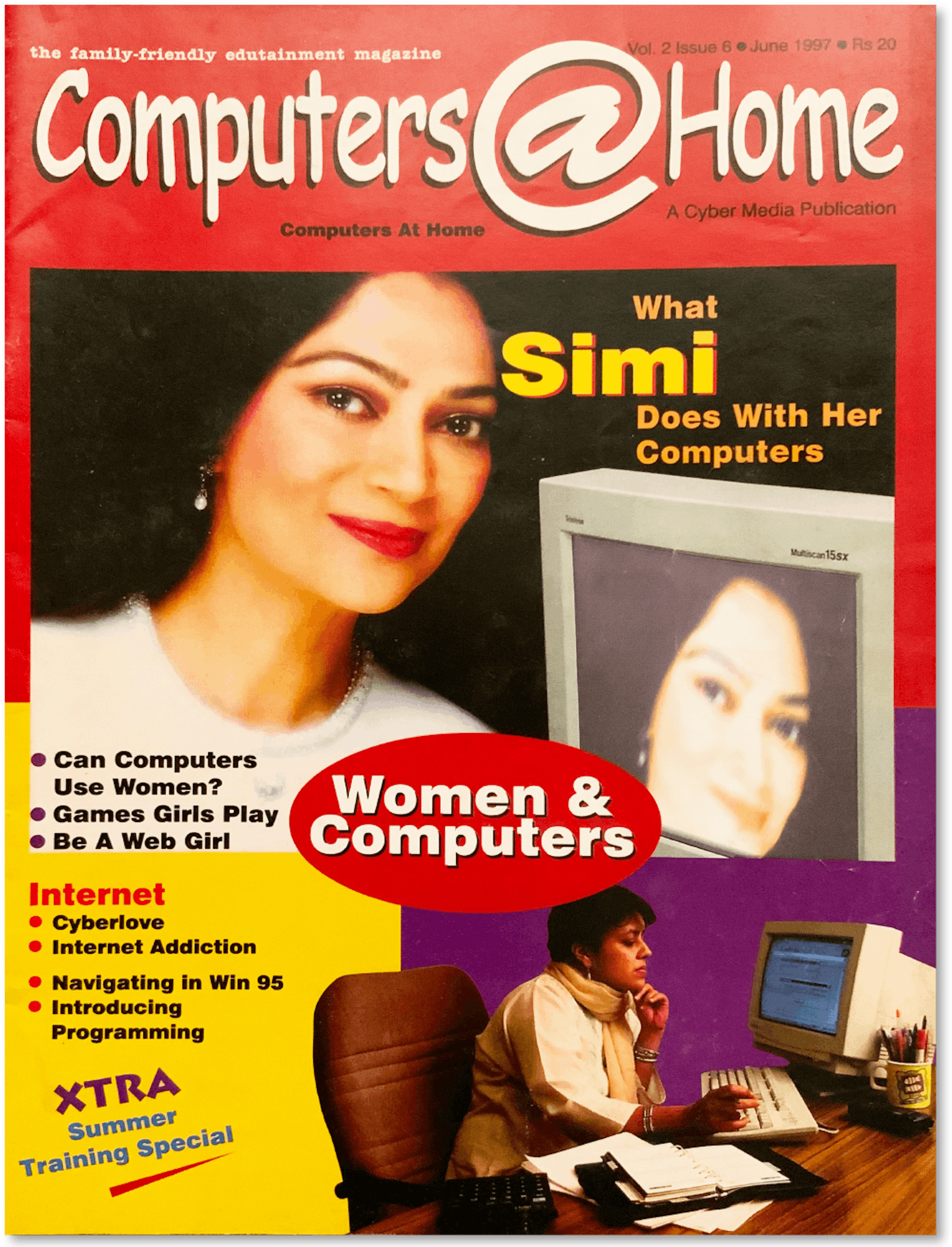
“Persuading users to adopt technology was so much at the core of Computers@Home that we collaborated with Intel to seed five computers in five homes to see how they fared,” recalls Nupur Chaturvedi, who was also an assistant editor. We also contacted well-known tech users and profiled them. One of these was then-actress Smriti Irani, who came from a tech-savvy family.
It wasn’t long before Computers@Home had some serious competition. Magazines Chip (launched in 1998) and Digit (born 2001) may not have done Computers@Home any good, but they certainly expanded the market for tech magazines. Beginning with PCQuest, every tech publication began to include a CD full of software, games and utilities. This was a big hit with readers.
Many of Computers@Home’s readers became contributors. Technology columnist Tushar Kanwar started out with C@H and still has a copy of every single piece he wrote for the magazine. “When I look at some of the articles I wrote then, it almost feels like placing a trunk call to distant relatives—it’s so archaic,” he says, “Did I really write ‘Excel, One Step at a Time?’ And ‘How to use Yahoo Pager?’ Looking at these today is like reading a history book on World War II.”
And then, boom
verything changed with the turn of the millennium. Online properties were bought, sold and publicly listed. We had entered the era of internet millionaires.
Cellphones made the Motorola pager obsolete, but they were a few years away from being ubiquitous. It was these gadgets that caused us to make our first typo in the magazine: ‘Litle culluphone.’ I was quite crushed.
We carried the first-ever cellphone reviews in India, though there was little to review back then. There were Motorola bricks and Nokia bricks and smaller Ericsson handsets and all you could do was call or send an SMS. But we still managed to have no end of fun with these features. Prasanto managed to spark off a fight between two colleagues at a quarterly managers meeting.
Colleague A sent a sneaky text to colleague B to please back the plan he was vociferously trying to push through. Instead of getting his support, he got a response that said ‘Quack quack!’ That began a nice little spat with much offence taken on both sides. “At that time, there were websites that let you send a text message from one number to the other and all you needed to know was the numbers,” says Prasanto. It contrasts so sharply with all the encryption we use today.
Gadgets began to pour in, including speakers and home theatre systems. “We could barely keep up and were always worried about missing out on some product or the other,” Suma remembers.
Writing on personal technology as opposed to enterprise tech was no longer the domain of a handful of magazines. Mainline newspapers and magazines started technology sections and pages. After getting C@H off the ground, I had started a column called “That’s IT” in Businessworld, one of the few at the time. Soon after, technology writing became less about persuasion and more about demystification.
Living Digital
t was inevitable that Computers@Home would have to change. The reader had matured and technology had become a permanent part of life. In 2003, Computers@Home was overhauled and rebranded as Living Digital.
“After a few years of running Computers@Home, one thing became obvious,” former managing editor Shyam Malhotra says. “Digital life was not just about computers. We had to ask ourselves whether we were addressing too niche an audience by limiting it with the name. While “computers at work” was an easily understood concept, “computers at home” was not. Living Digital had to become a wider platform on both the reader and advertiser front.”
We spent hours visualising a rebranded magazine and how it should be positioned. The content factories had begun churning out material by then. How could we break through the clutter? We went right back to Media Workshop to design a second avatar of the magazine that had grown up along with its readers.
We also needed a lifestyle look. Skimpily-dressed models shot by Atul Kasbekar replaced the homey scenes on the cover. Megabyte, the adorable mouse, packed her bags and left. The soft, slightly yellow pages were replaced by white glossy ones. The age of persuasion was well and truly over.
It was the first time I had seen a machine look outright beautiful.
By the mid-2000s, the tech world was buzzing with new gadgets and technologies. The Korean giants Samsung and LG had become fierce rivals in India. The Japanese and American behemoths—HP, Canon, Panasonic, Sony, Compaq—were pouring products into the market. Taiwanese company Acer was marketing aggressively.
Designers and creative folks were completely besotted by the Mac but the wider world hadn’t caught the Apple bug yet. Apple planted a few Macs at the PC Quest labs for us to try out. It was the first time I had seen a machine look outright beautiful. Earlier, they’d sent us some iPods to play with. Mine was a gorgeous black-and-red U2 special edition. It carried my whole music collection and I couldn’t be parted from it.
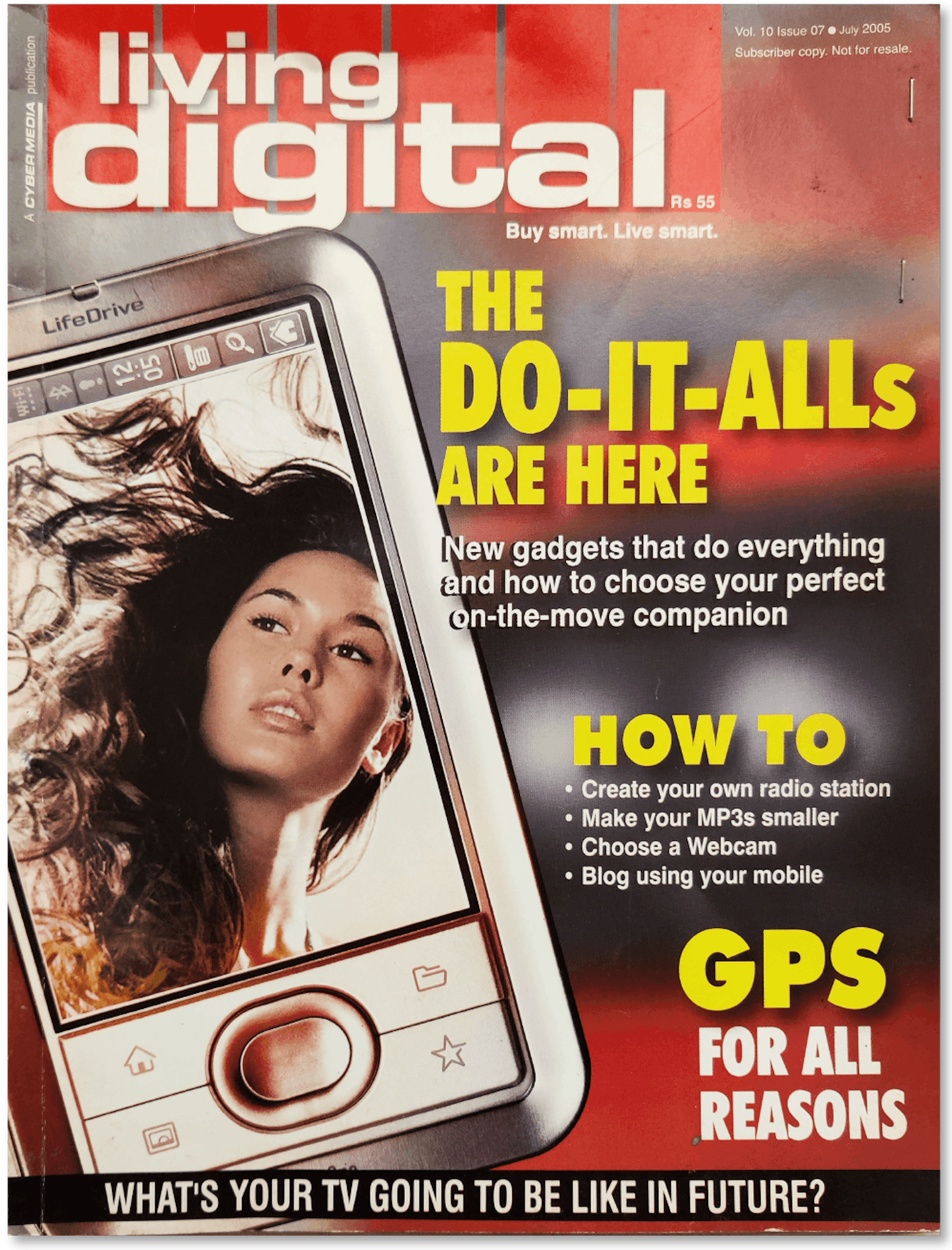
By then, Living Digital had journeyed far from the C@H we’d originally created. Many members of my team had drifted away and I too left the organisation. Hitesh Raj Bhagat was in charge of the magazine then. He recalls how the idea of mobile computing had taken over in the mid-2000s. Sophisticated review and news websites like Gizmodo and CNet had become increasingly popular and everyone in web publishing wanted to “optimise search.”
“Magazines didn’t really know what hit them. The expertise needed now was all online and it wasn’t what CyberMedia was great at. We diversified into areas like customised content for companies and began to see a decline,” Hitesh said. Today, CyberMedia sits in a corner of Gurgaon and has gone rather quiet.
In 2010, Living Digital went out of print. Advertising was just too hard to come by. The magazine wasn’t able to bring in much revenue even while having to commission huge print runs to compete with others, including mainstream publications. The dotcom bust and the subsequent, though temporary, disenchantment with technology hadn’t helped.
“CyberMedia essentially had a B2B mindset. Living Digital was entirely a B2C product and required a different approach and investment,” says Hoshie Ghaswalla, then group editor with the organisation. “That was just one of the challenges. In retrospect, discontinuing it was a wise decision. When people didn’t want to pay for superlative content, one would remain dependent on advertising. But that advertising had shifted almost totally to television and newspapers.”
By 2013, Living Digital was no longer even an online-only property.
A bit too personal
oday’s “everything-connected” era is quite a dramatic contrast to the hardware-focused concerns of a quarter century ago. If you’d asked me then, I certainly wouldn’t have guessed that technology would become so “personal” as to mean that Big Tech would know my name, address, where I’ve been and which flavour of ice-cream I like.
I wouldn’t have known that algorithms would make my decisions for me and lead me down paths I never set out for.
The optimism that used to drive my writing for magazines like Computers@Home and Businessworld has long evaporated. There has been a sneaking realisation that technology is not necessarily wholesome, family-friendly or deployed for the good of its users—just like the companies that develop the technology. Smarter and snazzier products are launched on a daily basis, but it is the software that has taken over our lives in ways that have eaten up our privacy and turned us into commodities.
Today, it’s hard to search for something with a clean slate—your choices are limited by what a tech company knows about you and wants to show you. We’ve long moved on from the age of the personal to the age of personalisation. Technology today is used by businesses to constantly answer the questions of how it can market you and how it can market at you.
My column for Businessworld ended in 2015 after a 20-year run. I couldn’t revive it at The Hindu BusinessLine where I now work. The sad truth is that I no longer feel the same enthusiasm and optimism about technology that I once had.
My house is filled wall-to-wall with gadgets awaiting review and they still excite me. But no matter how amazed I am at how AI may be deployed to detect a disease or how one’s brain can be connected to and controlled by the internet, I no longer believe, on balance, that technology will make the world a better place.
Mala Bhargava may have set out to be a clinical psychologist but instead became one of the first few writers focusing on personal technology in India. She has written for the publishing house CyberMedia, Businessworld, and is now a consultant editor with The Hindu BusinessLine.
